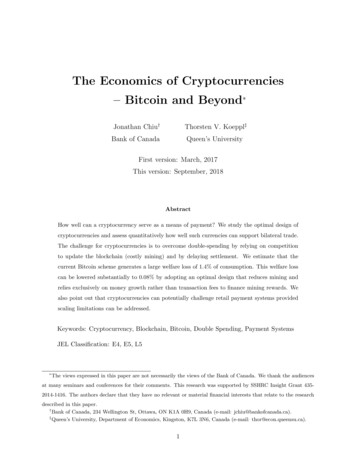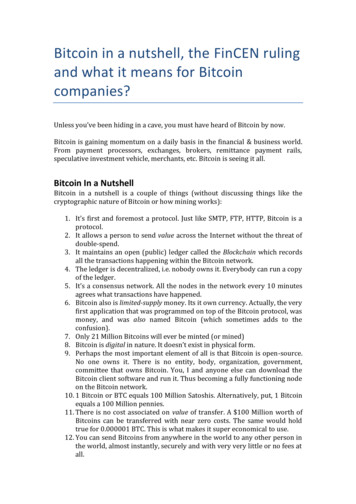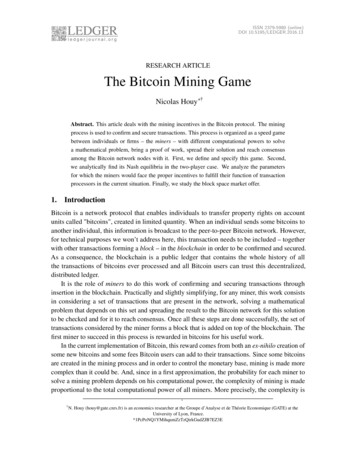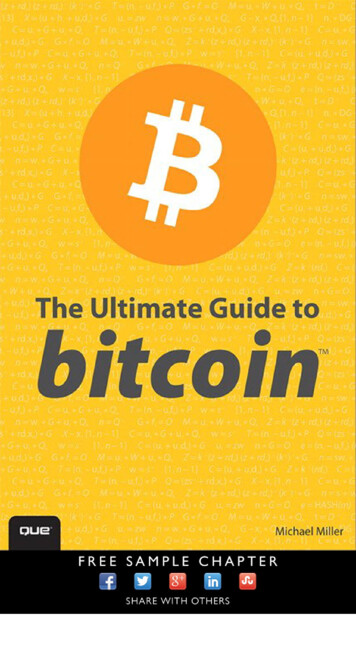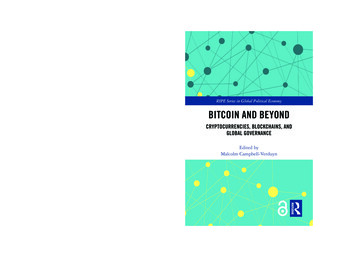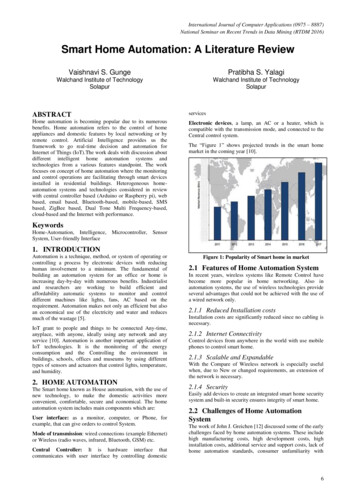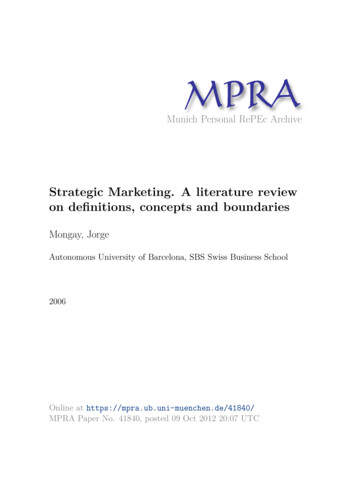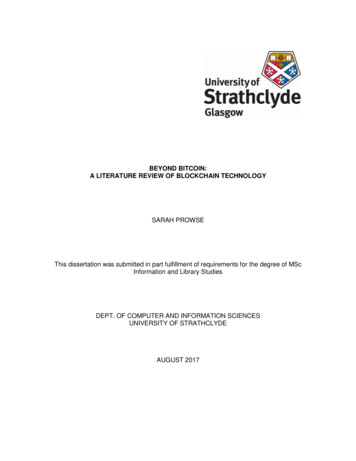
Transcription
BEYOND BITCOIN:A LITERATURE REVIEW OF BLOCKCHAIN TECHNOLOGYSARAH PROWSEThis dissertation was submitted in part fulfillment of requirements for the degree of MScInformation and Library StudiesDEPT. OF COMPUTER AND INFORMATION SCIENCESUNIVERSITY OF STRATHCLYDEAUGUST 2017
DECLARATIONThis dissertation is submitted in part fulfillment of the requirements for the degree of MSc of theUniversity of Strathclyde.I declare that this dissertation embodies the results of my own work and that it has beencomposed by myself. Following normal academic conventions, I have made dueacknowledgement to the work of others.I declare that I have sought, and received, ethics approval via the Departmental EthicsCommittee as appropriate to my research.I give permission to the University of Strathclyde, Department of Computer and InformationSciences, to provide copies of the dissertation, at cost, to those who may in the future request acopy of the dissertation for private study or research.I give permission to the University of Strathclyde, Department of Computer and InformationSciences, to place a copy of the dissertation in the publicly available archive.(please tick)Yes [ x ]No [ x ]I declare the word count for this dissertation (excluding title page, declaration, abstract,acknowledgements, table of contents, list of illustrations, references and appendices is: 20,160I confirm I wish this to be assessed as a Type:1[x]Dissertation (please circle)Signature:Date: August 18th, 2017i2345
ABSTRACTBlockchain, the technology that underlies the first and most widely known cryptocurrencyBitcoin, is a shared digital ledger that records transactions occurring across a distributed orpeer-to-peer network. However, despite its potential for domains outside of finance, muchconfusion still exists surrounding both the technology and its applications. The overarching aimof this extended literature review is to identify current and emerging application domains andtheir requirements for blockchain technology, including potential observed challenges.The incorporation of both academic sources and ‘grey’ literature yield a diverse variety of resultswith applications found in the fields of finance, government, healthcare, and the sharingeconomy. The text does not intend to provide an overly technical perspective, but instead offersan accessible foundation in key terms and concepts relevant to discussions of blockchaintechnology and its applications. The role of the information professional as an advocate for theunderstanding of new technological advances is also considered. With misinformation rifesurrounding the use of blockchain technologies, information professionals may serve as onetrusted and reliable outlet for public discourse surrounding new media.It was discovered that the current literature exhibits a number of core similarities in applicationpurpose such as the movement of assets, new modalities of verification, proof of ownershipand/or traceability, and interrelationships with the concept of identity. However, noticeablylacking are cohesive frameworks and methodologies to evaluate the success of both technicalblockchain applications and their wider social applicability. Recommendations include theimplementation of social education campaigns for widespread uptake and acceptance, the needfor governments and social leaders to work cohesively when advocating for, and regulating,potentially disruptive technologies such as the blockchain, and the role of academic andjournalistic media outlets in providing information that is concise and accessible to a wideaudience.ii
ACKNOWLEDGEMENTSThank you to all my wonderful colleagues. I have been lucky enough to learn from anexceptional group of individuals this year, and I couldn’t be more grateful. Special thanks toKatie, Bethany, and Bec for making me smile again and Laura for being a green-hairedCanadian’s best friend.I am much obliged to Dr. Sotirios Terzis for his supervision and guidance, and Ms. Zakia Majidfor all that she does.Dedicated to Warren, who I know would have loved this topic.iii
TABLE OF CONTENTS1.INTRODUCTION11.1Overview11.2Research Inputs52.3Processing72.4Outputs72.5Risk analysis83.A BLOCKCHAIN PRIMER93.1Introduction93.2How does blockchain technology work?93.3What can the blockchain do?163.4Why do we need blockchain?183.5Summary and analysis204.CRYPTOCURRENCIES AND THE FINANCIAL SPHERE234.1Introduction234.2Cryptocurrencies and blockchain234.3The financial sphere274.4Regulation – cryptocurrencies, blockchain, and beyond304.5Summary and analysis325.BLOCKCHAIN AND GOVERNMENT345.1Introduction345.2Identity records345.3Land registry375.4Elections395.5Summary and analysis42iv
6.BLOCKCHAIN AND HEALTHCARE446.1Introduction446.2Healthcare management446.3Medical Research476.4Pharmaceuticals and fraud detection496.5Summary and analysis507.BLOCKCHAIN AND THE SHARING ECONOMY527.1Introduction527.2Social media527.3Retail industry: the exchange of goods and services557.4Libraries, e-books, and the future of literary lending577.5Summary and analysis598.CONCLUSIONS, RECOMMENDATIONS, AND 3Reflection64REFERENCES66APPENDIX 1: ANNOTATED REFERENCE LIST79v
CHAPTER 1: INTRODUCTION1.1 OVERVIEWBlockchain, the technology that underlies the first and most widely known cryptocurrencyBitcoin, is a shared digital ledger that records transactions occurring across a distributedor peer-to-peer network. Public or private in nature, enhanced cryptography validatesand ‘chains’ data blocks creating immutable record of transactions. As Howley (2016, p.14) describes: “It is a piece of software that enables a minor miracle: the ability to createvalue in an open setting (open to participants from the world at large) but in a completelysecure, mutually inter-conscious environment”. However, despite current hype, theblockchain concept is mired in misinformation and technical jargon, making it “one of themost misunderstood technologies of 2017” (R. Das, 2017).While much of the current literature centers on the use of blockchain within financialtransactions, new applications are emerging within a wide variety of domains. Iansiti andLakhani envision the potential for blockchain technologies:With blockchain, we can imagine a world in which contracts are embedded indigital code and stored in transparent, shared databases, where they areprotected from deletion, tampering, and revision. In this world every agreement,every process, every task, and every payment would have a digital record andsignature that could be identified, validated, stored, and shared. Intermediarieslike lawyers, brokers, and bankers might no longer be necessary. Individuals,organizations, machines, and algorithms would freely transact and interact withone another with little friction. This is the immense potential of blockchain(Iansitia and Lakhani, 2017).Platforms such as Ethereum and Bitcoin aim to provide development support toblockchain applications, while major global data infrastructure firms and corporations areembracing the technology within new domains such as government, healthcare, and thesharing economy (Ethereum, 2017; Bitcoin, 2016). Such advancements are reflected inthe recent literature surrounding blockchain technology, and merit further scholarlyexploration as provided by an extended literature review.Page 1
1.2 RESEARCH QUESTIONSWebster and Watson (2002, p. 13) note an effective literature review “creates a firmfoundation for advancing knowledge. It facilitates theory development, closes areaswhere a plethora of research exists, and uncovers areas where research is needed”. Assuch, this review seeks to address the following primary questions: What are the current application domains for blockchain technology? What are the requirements of such domains for blockchain technology? What potential challenges must be overcome within such domains for widerapplicability of blockchain technology?And, if supported by the literature: What is the potential impact of blockchain technology to library practice?In discussing the breadth of domain applicability of blockchain technologies, Swanobserves:We should think about the blockchain as another class of things like the Internet– a comprehensive information technology with tiered technical levels andmultiple classes of applications for any form of asset registry, inventory, andexchange, including every area of finance, economics, and money; hard assets(physical property, homes, cars); and intangible assets (votes, ideas, reputation,intention, health data, information, etc) (Swan, 2015, p. vii).The research questions are supported by a number of objectives including: working tocategorize themes relevant to the current literature surrounding blockchain technologyand its application, identifying models or frameworks for further analysis, anddetermining gaps within the literature for additional exploration.The overarching aim seeks to “assemble the literature being reviewed for a givenconcept into a whole that exceeds the sum of its parts” (Levy and Ellis, 2006, p. 200).Page 2
Therefore, the primary learning outcome for the reader will be to not only identify currentpractices focused on financial transactions and the predominance of Bitcoin within thebody of knowledge, but to identify facets of literature that address blockchain technologyas a new paradigm for organization with applications across multiple disciplines. Furtheroutcomes include identifying common themes present through all domains, theidentification of gaps for further exploration within the literature, and a reflection on therole of the information professional as it relates to such emerging technologies.1.3 REPORTThis review is divided into the following subsequent chapters:Chapter 2 provides an overview of the methodologies used during the literature review,including rationale for inputs, outputs, and processing as recommended by Levy andEllis (2006). Issues of citation and formatting are also discussed.Chapter 3 introduces a brief technical foundation of blockchain technologies. Thischapter aims to bridge the gap between commercially available definitions that areuninformative and the overly technical jargon of computer science specialists andblockchain developers.Chapter 4 discusses the role of blockchain within its most widely cited domain –cryptocurrency. However, consideration is also given to applicability within the widerfinancial sphere and subsequent regulatory and legislative issues.Chapter 5 reviews the use of blockchain within government applications, includingidentity documents, land registries, and voting technologies.Chapter 6 provides an overview of blockchain technologies within the domain ofhealthcare. Current trends exhibit application for multiple facets of healthcaremanagement, medical research, and fraud detection within the pharmaceutical industry.Chapter 7 explores the relationship and applicability of the blockchain to the sharingeconomy. Examples from within the literature will draw on a wide variety of subdomainsincluding social media, the retail industry and exchange of goods and services, and thePage 3
role of libraries as new technology mediators.Chapter 8 offers final conclusions, recommendations, and personal reflections. Thisincludes: identification of common themes across domains, recognized gaps in publiceducation and development of both regulatory frameworks and scientific methodologies,and potential implications to the role of information professionals.In the interest of advancing the knowledge of subsequent researchers, the sole enclosedappendix is compiled of an annotated bibliography for all references within the review.These records detail access sources, search strategies, keywords, and other relevantparticulars that may be of use to future blockchain related research endeavors.Page 4
CHAPTER 2: METHODOLOGY2.1 RATIONALELevy and Ellis (2006, p. 181) observe: “The need to uncover what is already known inthe body of knowledge prior to initiating any research study should not beunderestimated”. Exploratory literature reviews of an extended nature allow for asynthesis of material that may yield results outside of widely cited disciplines, such asthe potential applicability of blockchain technology to domains extending beyondcryptocurrencies. Levy and Ellis (2006, p. 208) advocate a sequential method of inputs,processing, and outputs, which aim to “decompose the task of the literature review intothe three manageable stages”. Oliver (2012) and Jesson et al. (2011) further supportsequential stages as a means of mitigating potential risks to the novice researcher withinthe literature review process. What follows is the methodology used for this review,including a system of processing academic and grey literature inputs to reach a finalliterature review output including associated risk considerations.2.2 INPUTSThe intended primary source of input for this literature survey was peer-reviewedmaterial as published in a variety of academic journals available via the University ofStrathclyde. Davison, Vreede and Briggs (2005, p. 969) note the peer review process isessential as it allows the novice researcher to “use published work with confidence, anduse the works of others as stepping stones and corner stones for advancing newconcepts and insights”. However, academic standards vary widely by publication anddiscipline. The University of Strathclyde LibGuides, composed by subject librarians, wereconsulted to ensure quality of access within each domain.As Oliver notes of exploratory areas for development:The advantage of a new topic is that it is likely to be a relatively under-researcharea, and therefore offers new opportunities. On the other hand, with new topicsit is not always easy to identify research samples when there is not a great dealof existing previous research to act as a model” (Oliver, 2012, p. 17).As a result, “grey material” as described by Oliver (2012) including government reports,Page 5
white papers, conference proceedings, and other sources of journalistic literature havealso been sourced and evaluated for their contribution to the overall body of knowledge.Keyword searching provided the inaugural method of sourcing input, although ”keywordsearch should be just the initial, not the main step for a literature search” (Levy and Ellis,2006, p. 190). Keyword searching alone yielded limited depth and scope of blockchaintechnology and was used in conjunction with backwards and forwards searchingmethodologies. Backwards searching utilizes the cited references of academic writingsto source additional literature, while forward searching seeks new publications bypreviously identified authors. A combination of all three approaches provides a scopebeyond buzzwords, providing additional insights to future developments within theliterature.Jesson et al. (2011) emphasize the importance of a detailed search log during the initialinput stage; Levy and Ellis (2006) further propose the use of annotated bibliographiesduring the search process. For the purposes of this review, Microsoft Access has beenused to create a hybrid of both search log and annotated bibliography (see Appendix 1);this was used to create a simple database system within the search process, allowing fora complete capture of records that can further be queried for specific inputs.Fig.1: Example database record from Appendix 1REFERENCE: Lemieux, V. (2016) ‘Trusting records: is Blockchaintechnology the answer?’, Records Management Journal,26(2), pp. 110-139.DATE ACCESSED: March 8, 2017ACCESS SOURCE: Emerald InsightKEYWORDS/STRATEGY: Reliability, Authenticity, Risk, Digital preservation,Blockchain, Trusted digital repositoryOTHER: Cited by Morabito, V. (2017)Lemieux (2016) provides one example in which blockchain technology has beenimplemented to ensure trustworthiness of digital records within the land registry systemof the Honduran government (utilizing Factom, a leader in data infrastructure). Lemieux’sfindings “suggest that Blockchain technology can be used to address issues associatedwith information integrity in the present and near term, assuming proper securityarchitecture and infrastructure management controls. It does not, however, guaranteereliability of information in the first place, and would have several limitations as a longterm solution for maintaining trustworthy digital records” (p. 110).Fig.1: Example database record from Appendix 1Page 6
Leedy and Ormrod (2015, p. 190) note: “the search is near completion when onediscovers that new articles only introduce familiar arguments, methodologies, findings,authors, and studies”.2.3 PROCESSINGOliver (2012) describes processing the literature as a combination of selectingappropriate literature for inclusion within the review, and analysis and categorization ofsuch literature for final output. Of the former, appropriate literature was evaluated by anumber of means including perceived validity (often based on a peer review process orcitations of the work by additional scholars), methodologies within the literature yieldingreplicable or scientifically valid outputs, cohesive writing including efficacy of arguments,and the objectivity of scholars in identifying potential limitations of their writings. Therecency of writings was of less concern to the topic of blockchains, as the technologyhas risen to prominence within the last decade.Categorization and critical analysis of the literature for common themes was conductedusing the qualitative software NVivo. NVivo was used to identify patterns and themeswithin the current blockchain literature based on concept nodes and utilizing keywordqueries. This further highlighted gaps in the body of knowledge, and assisted in weedingmaterial sourced during the input stage. Jesson et al. (2011) argue that a process ofcodification of literature can also assist in comparing and contrasting scholarly materialduring the final output stage.2.4 OUTPUTSThe final output as a result of inputs and processing is the literature review itself. Inevaluating literature and the writing process Booth, Colomb and Williams (2008, p. 112)provide a helpful nuance for argumentation theory noting an effective review can providea “[claim] because of [reason] based on [evidence]”. Jesson et al. (2011, p. 88)encourage the novice researcher to “dare to have an opinion” on the synthesizedliterature, as a rote recitation of findings does not encourage further scholarly discussionor attempt to bridge gaps in the current body of knowledge. In merit of this suggestion, afinal reflection on the part of the researcher has been included at the end of the review.The final conclusions and recommendations aim to compare and contrast results acrossdomains as a means of contributing further to applicable academic discourse.Page 7
It should be noted that referencing throughout the review follows Harvard style citationas recommended by the University of Strathclyde from Pear and Shields (2016). As perthe Department of Computer and information Sciences PGT Dissertation Handbook forthe academic year 2016/17, quotes in excess of approximately two lines have beenindented with the reference placed in quotations at the end of the quotation.2.5 RISK ANALYSISBem (1995, p. 172) observes, “authors of literature reviews are at risk for producingmind-numbing lists of citations and findings that resemble a phone book – impressivecase, lots of numbers, but not much plot”. While this may be true of blockchaintechnologies within cryptocurrencies and finance, the proposed topic remains a relativelyinnovative concept to many other disciplines and cross-disciplines. While it wasanticipated this may cause difficulty in sourcing appropriate academic material to furtherthe body of knowledge within identified gaps, ultimately the ‘grey literature’ included forreview provided source material that was as relevant as the date of final submission. Itwould have been a disservice to the review to exclude journalistic content as it canprovide debatable merit and lively discussion for a continually evolving domain such asblockchain technologies.Appropriate referencing and citation is also of the utmost importance throughout theliterature review process. Levy and Ellis (2006) caution that unethical use of referencing,whether material taken out of intended context or misquoted, may damage not onlyindividual reputation but also the integrity of a field as a whole. Unethical referencingwas avoided through a carefully devised search log and series of annotations, in additionto the use of qualitative software such as NVivo for further tracking.Finally, the topic of blockchain and its applications may be perceived as overly complexto those without a computer science background. The aim in writing will be to presentcore technical concepts with limited scientific jargon, creating an accessible means ofunderstanding for those without an in-depth background to the topic at hand.Page 8
CHAPTER 3: A BLOCKCHAIN PRIMER3.1 INTRODUCTIONAmbiguity exists within the literature as the term blockchain can refer to a datastructure, algorithm, a group of technologies, and/or as a definition used for distributedpeer-to-peer systems with a common application system (Drescher, 2017, p. 33). A datastructure is a means of organizing information, with blockchain referring to data in‘blocks’ that are connected to one another not unlike a chain. Blockchain as an algorithmrefers to a series of computation instructions that “negotiates the informational content ofmany blockchain-data-structures in a purely distributed peer-to-peer system” (Drescher,2017, p. 34). As a group of technologies, the term blockchain can encompass both datastructures and algorithms, in addition to cryptographic and security measures that seekto maintain integrity within distributed systems. Finally, blockchain may refer to peer-topeer systems of ledgers that implement blockchain technologies including datastructures, algorithms, and cryptographic measures. What follows is a simplifieddiscussion of blockchain basics, including frequently cited terminology and a preliminaryoverview of the how, what, and why of current and potential blockchain industry.3.2 HOW DOES BLOCKCHAIN TECHNOLOGY WORK?In discussing blockchain technology Drescher (2017) first suggests a brief analysis ofsoftware systems in terms of layers (application versus implementation) and aspects(functional versus non-functional). The application layer refers to the needs of the user,while the implementation layer consists of the technical elements required to fulfil suchneeds. The functional aspects of a system are the most obvious as they serve the facevalue needs of the user (what is done) while the non-functional aspects work ‘behind thescenes’ (how things are done). Drescher (2017) utilizes the example of a mobile phoneto illustrate both layers and aspects, as illustrated in Figure 2.Page 9
LayerFunctional Aspects Taking photos Making phonecalls Sending e-mails Browsing the Internet Sending chat messagesImplementation Saving user datainternally Connecting to thenearest mobile network Accessing pixels in thedigital cameraFig.2: Layers and aspects of mobile phoneAdapted from Drescher (2017)ApplicationNon-functional Aspects The graphical userinterface looks beautiful Easy to use Messages are sent fast Stores data efficientlySaves energyMaintains integrityEnsures user privacyNot unlike a mobile phone, blockchain also offers multi-dimensional layering to ensure anumber of essential aspects. Gibson (2011) notes: “Most IT security practices arefocused on protecting systems from loss of confidentiality, loss of integrity, and loss ofavailability. These three together are referred to as the security triad, the CIA triad, andthe AIC triad”. The security triad is composed of the following, as described by Gibson(2011):1.Confidentiality: set of rules that limits access to information2.Integrity: assurance that the information is accurate and trustworthy3.Availability: reliable access to the information by authorized persons or usersThe way in which system components are related to one another and organized isknown as software architecture. Baran (1964) is often cited as first to describe the majorarchitectural approaches for software systems, namely: centralized, decentralized, anddistributed. As Szmigielski illustrates in Figure 3 of a centralized network:A centralized network is depicted as a star. Every node is connected to a centralnode. It is clear that by taking out the center node, the network breaks down.Examples could include any structure where there is a central authority andeveryone reports to it (Szmigielski, 2015).Page 10
Fig.3: Centralized networkSzmigielski (2015)Szmigielski goes on to further describe decentralized networks, as seen in Figure 4:[.] a decentralized network, there is no obvious center. In order to break thisnetwork completely the four red nodes would have to be destroyed. Or thehighlighted communication links would need to be taken out. Note that takingout the links segments the network into smaller subnetworks (Szmigielski, 2015).Fig.4: Decentralized networkSzmigielski (2015)Drescher (2017) observes that decentralized networks offer advantages in terms ofPage 11
tolerance to faults, efficacy in creating network links, and difficulty in shutting down theentire network. Finally, Szmigielski discusses distributed systems as seen in Figure 5:But what if we want a network that is almost impossible to destroy. All that isneeded is for each node to have multiple connections to as many other nodes aspossible, and the ability to forward traffic on its way to some destination. Theresult will be a distributed network[.]In a distributed network a node has asmany connection as possible to other nodes. Therefore disruptingcommunication amounts to almost destroying every node or every link. Everynode is now capable of forwarding communication from other nodes. It acts as aserver for others, and of course as a client for itself (Szmigielski, 2015).Fig.5: Distributed systemSzmigielski (2015)Szmigielski (2015) observes there is often confusion in discussing distributed versusdecentralized systems: “The main difference is that in truly distributed networks eachnode has multiple connections and can act as a server”. With this in mind, theblockchain operates on a distributed system that offers several advantages includingincreased computing power and the ability for the system to grow organically (Frances,2015). Computing power is a product of all connected computers on the system, whichlends to reliability as the network can continue to operate should a single point of failureoccur. As more computers are connected to the system, power can be increasedincrementally allowing the system to naturally grow in scope (Gupta, 2017).A peer-to-peer (often cited as P2P) network is a type of distributed system that allowsindividual computers the ability to share their computational resources with otherPage 12
members of the network without the need for a central point of coordination (i.e. –decentralized) (Gupta, 2017). Individual computers are also known as nodes, with eachnode acting as both a supplier and consumer of resources within the system (Gupta,2017). Architectural models can also be mixed in nature, offering elements of both acentralized and distributed system (see Figure 6). Software architecture may be selectedbased on available resources, desired implementation to a previously existing system, oras an innovative means of change.Fig.6: L: Central component within a distributed system, R: Internal distributed systemconnected to external centralized systemDrescher (2017)Recall the security triad described by Gibson:If a system suffers loss of confidentiality, then data has been disclosed tounauthorized individuals[.]Loss of integrity means that data or an IT system hasbeen modified or destroyed by an unauthorized entity[.]Availability ensures thatdata and systems are up and operational when they are needed (Gibson, 2011).To achieve and maintain the security triad there must also be an element of trust, bothin users and the system. As Drescher (2017, p. 31) describes: “The core problem to besolved by the blockchain is achieving and maintaining integrity in a purely distributedpeer-to-peer system that consists of an unknown number of peers with unknownreliability and trustworthiness”. An oft-cited metaphor for this quandary is Lamport,Shostak, and Pease’s 1982 Byzantine Generals’ Problem.Page 13
In this scenario a group of generals, each commanding one faction of a Byzantine army,surround a city or castle. Some generals may wish to attack, while others prefer toretreat. Traitorous generals who selectively vote for a suboptimal strategy (i.e. –indicating a retreat vote to one group of parties, and a vote to attack to others)complicate the problem further, creating possible detrimental results due to a lack ofcohesive strategy. The generals are also physically separated and must rely onmessengers, whom may or may not prove trustworthy, failing to deliver votes orproviding false information. This metaphor reflects a key issue within computing – thecoordination and decision of action through unreliable or suboptimal links or means ofcommunication.One means of solving the Byzantine Generals’ Problem using the blockchain is througha concept known as proof of work. Proof of work validates transactions submitted to theblockchain through a collective process known as ‘mining’ in which miners must solve amathematical puzzle derived from the transaction’s header before a new block can beadded to the chain. Keyser (2017) provides an illustrative example of the blockchainprocess (see Figure 7). As transactional blocks
Canadian’s best friend. . e-books, and the future of literary lending 57 7.5 Summary and analysis 59 8. . 1.1 OVERVIEW Blockchain, the technology that underlies the first and most widely known cryptocurrency Bitcoin, is a shared digital ledger that records transactions occurring ac
